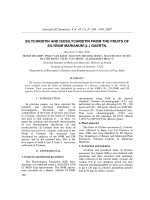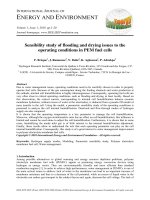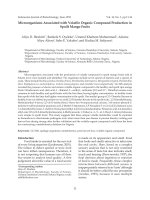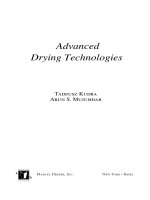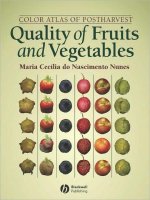drying fruits & vegetables
Bạn đang xem bản rút gọn của tài liệu. Xem và tải ngay bản đầy đủ của tài liệu tại đây (422.72 KB, 32 trang )
Fruits & Vegetables
DRYING
A Pacific Northwest Extension Publication
Idaho • Oregon • Washington
PNW 397
2nd
Edition
Contents
Introduction 1
Drying Methods 2
Selecting Foods for Drying 4
Preparing Foods for Drying 5
Pretreating Fruits and Vegetables 6
Drying in a Dehydrator 10
Packaging 13
Storage 14
Making Fruit Leathers 15
Drying Guidelines for Fruits 18
Drying Guidelines for Vegetables 20
Enjoying Dried Foods 23
Recipes 24
Questions and Answers 28
The authors—Marilyn A. Swanson, former Extension Food Safety
Specialist, School of Family and Consumer Sciences, University of Idaho.
Revised by Sandra M. McCurdy, Extension Food Safety Specialist, School of
Family and Consumer Sciences, University of Idaho, in collaboration with
extension specialists at Oregon State University and Washington State
University.
Cover photo—Dishes prepared from dried fruits and vegetables (top to
bottom) are Tangy Golden Fruit Snacks, Dried Vegetable Quick Bread, and
Tangy Stewed Fruit.
Drying foods yourself allows you to choose the best, tastiest varieties
you can buy or pick fresh from the garden. Home drying also lets you
enjoy dried fruits and vegetables the grocery stores don’t carry. Dried
berries make wonderful additions to winter muffins. Dried tomatoes
perk up a pot of baked beans. Backpackers let lightweight dried veg-
etable mixes simmer into tempting soups. And the foods you dry your-
self cost a lot less than the ones you buy.
Microorganisms and enzymes that spoil food need water to be active.
Drying works as a preservation method simply by depriving them of
water.
Unlike canning, in which you follow precise instructions for packag-
ing and processing times to keep the food safe to eat, food drying is
flexible. Decisions about food-piece sizes, food mixtures, pretreatments,
and packaging are yours. Drying time is determined less by the clock
than by simple tests you perform.
Almost any food-safe packaging will do for dried foods. And, unlike
canned foods, packages can be opened and closed again and again.
High-quality, moderately priced electric dehydrators are widely
available. Easy to use and needing little care, they produce a consistently
top-quality product. For these reasons, most people buy or borrow
electric dehydrators rather than use their oven or the sun. Whatever
drying method you choose, the principles in this guide will apply.
Introduction
1
Drying Methods
Foods can be dried in an electric dehydrator, in the sun, in a solar
dryer, or in a regular oven.
Dehydrator Drying
Dehydrator drying produces the best quality dried products, so it’s
not surprising that it’s also the most popular drying method. Dehydrator
drying also gives you greater flexibility than other methods because it
does not depend on dry, sunny days or take over your oven. A variety of
electric dehydrators are available for purchase. A dehydrator should have
a heat source, a thermostat, and some method of air circulation. If you
buy a dehydrator, follow the directions that come with it.
Buying a Dehydrator
Before you buy a new or used food dehydrator, check to see that it
has all these features:
• Instruction manual.
• Thermostatically controlled temperature dial with settings between
130° and 150°F.
(If you plan to dry meat jerky in your dehydrator, the dehydrator
must be capable of maintaining a temperature of 145˚. Contact the
extension educator in your county for instructions on how to safely
prepare meat jerky.)
• Fan or blower to distribute warm air evenly.
• Shelves made of stainless steel or food-grade plastic. (Galvanized
screening is not food-safe.)
• Easy loading and unloading features.
• Outside cabinets made of hard plastic, aluminum, or steel. The
highest quality dehydrator has
double-wall construction with
insulating material sand-
wiched between the walls to
reduce the amount of heat lost
during use.
• Enclosed heating element.
2
3
• Appropriate number of trays for your use. Most food dryers come
with 4 to 10 food trays.
• Source of replacement parts.
Sun Drying
Sun drying works best when the
temperature is in the 90s, the humidity is
low, and air pollution levels are low. A
major advantage to sun drying is its low
cost. Drying trays, netting to protect
against bugs, and food to dry are your only
investments.
Sun drying makes you dependent on
the weather, however. If it is sunny one day
and cloudy the next, you will have to finish
drying by another method. That’s because
spoilage can occur while the drying food
still has enough moisture for microbial growth. Also, you should bring
the food inside on cool nights. Another disadvantage is time. What dries
in 6 to 8 hours in an electric dehydrator may take 2 to 4 days in the sun.
Solar Drying
Solar drying is like sun drying, only better. The sun’s rays collect in a
solar box so that, compared with sun drying, drying temperature is
higher and drying time is shorter. The shorter drying time gives microor-
ganisms less chance to cause spoilage.
If you do not want to buy or build a solar box, you can use the back
window ledge of an automobile where the sun shines through. Crack the
windows slightly to allow air flow so temperatures do not get too hot.
Cover the trays with netting to keep bugs out.
Oven Drying
You can use your oven to dry small amounts of food at one time.
You’ll have little or no investment in equipment and you won’t have to
depend on the weather.
Although oven drying produces a safe, generally tasty product, don’t
expect top quality. Oven-dried food is more brittle and usually darker
and less flavorful than food dried in a dehydrator. Another disadvantage
of oven drying is its energy cost. Oven drying takes two or three times
longer than drying in a dehydrator.
Before drying in an oven, test the oven temperature with an oven
thermometer for about 1 hour. Prop open the oven door as you would
when actually drying fruit. The oven should maintain a temperature of
130° to 150°F.
If the oven cannot maintain a temperature in this range, you will not
have high-quality dried food. If the oven is too hot, your food will begin
to cook instead of dry. If it is too cool, your
food may not dry fast enough and spoil
instead.
Selecting Foods for
Drying
Fruits
If you’re new to drying, start with
the fruits you like best. Think also
about how you will use your dried fruits.
Peaches or pears in a tangy stewed fruit? Apples
or apricots for lunch box snacks? Berries to toss into muffin or cake
batters? Most fruits are easy to dry.
High-quality fruits make the best dried products. Choose firm, fully
ripe fruit that is heavy for its size. Handle fruits gently and process them
immediately because fruit ready for drying is very fragile. Use overripe or
bruised fruits in other ways (for example, as fruit leathers).
Vegetables
Vegetables for drying should be fresh, tender, and just mature. Avoid
immature vegetables because their color and flavor tend to be weak or
poor. Also avoid excessively mature vegetables, which are inclined to be
tough, woody, or fibrous. For the best quality and nutrition, dry veg-
etables as soon as possible after harvest.
4
Preparing Foods for Drying
For suggestions for specific fruits and vegetables, see the drying
guidelines beginning on page 18.
Fruits
Gently wash all fruits in cold water just before drying to remove dirt,
bacteria, and insects. Thoroughly wash fruits that have skins you will not
peel off, such as cherries and prunes. Do not soak fruit because extended
soaking can cause nutrient loss and waterlog the fruit, which increases
drying times.
Remove fruit stems and peels. Peels may be left on some fruits, such
as apples and peaches, but they may become bitter or discolor during
drying. Core or pit the fruit and cut it into uniform halves, quarters, or
slices. Trim away diseased or soft spots.
Vegetables
Wash vegetables in cold water just before drying. If vegetables are
covered with soil, wash them under clean running water to prevent the
dirt from resettling on the food. Do not allow vegetables to soak in
water.
Most vegetables should be peeled and trimmed then cut, sliced, or
shredded into uniform pieces. Although peeling some vegetables such as
young zucchini and well-washed carrots is optional, unpeeled vegetables
tend to be tougher when dried. Remove fibrous or woody portions and
damaged areas. You can prepare pieces with a food slicer or food proces-
sor.
5
Pretreating Fruits and Vegetables
See the drying guidelines on pages 18 through 22 for specific details.
Although you can dry and store many foods without pretreatment,
pretreatment generally improves quality, particularly for vegetables. Five
major reasons for treating foods before drying are to
1. Preserve color and flavor
2. Minimize nutrient loss
3. Stop decomposition (enzyme action)
4. Ensure more even drying
5. Extend storage life
Pretreatment Methods for Fruits and Vegetables
Fruits Vegetables
Ascorbic acid/citric acid dips Steam blanching
Salt solution dip Water blanching
Syrup blanching
Honey dip
Sulfiting
Pretreating Fruits
Decomposition from enzyme action during storage is less a problem
with fruits than it is with vegetables. Fruits have higher levels of sugar
and acid, which counteract enzyme action. Although pretreating fruit is
not necessary, you can use an ascorbic acid/citric acid dip, a salt solution
dip, syrup blanching, a honey dip, or a sulfiting procedure. Certain
fruits, such as apricots, pears, peaches, and some varieties of apples, tend
to discolor with drying. Pretreating those fruits can decrease browning
during processing and storage and lower losses of flavor and of vitamins
A and C.
If you use a pretreatment method that requires soaking fruits in a water
solution, you will need to increase drying time because the fruit will absorb
some water. Do not allow foods to soak more than 1 hour.
6
7
Ascorbic Acid/Citric Acid Dips. Ascorbic acid/citric acid dips are
often used as a pretreatment for fruits. They prevent fruits such as
apples, pears, peaches, and apricots from turning brown when cut and
exposed to air. An ascorbic acid dip also increases the vitamin C content
of the dried fruit. (Ascorbic acid is another name for vitamin C.) Use
U.S.P. ascorbic acid or food-grade ascorbic acid, which are seasonally
available among canning supplies in supermarkets. Vitamin C tablets can
also be used.
To prepare an ascorbic acid solution, combine
1
/2 teaspoon of ascor-
bic acid crystals, or three crushed, 500-milligram tablets of vitamin C,
with 1 quart water. Stir until the ascorbic acid dissolves. Place the cut
fruit in the ascorbic acid solution. Stir the fruit to ensure even coating.
Leave the fruit in the ascorbic acid solution for about 5 minutes. Ap-
proximately 1 quart of solution will treat 8 cups of fruit.
Pineapple juice or juice from citrus fruits such as oranges, lemons, or
grapefruit can also be used as a pretreatment. These juices contain a
mixture of citric and ascorbic acids. However, citric acid is a weaker acid
than ascorbic acid and is less effective as a pretreatment.
You can also use a commercial pretreatment such as the anti-darken-
ing powders often sold with food preservation supplies. Follow the label
directions.
Salt Solution Dip. Prepare a solution of 2 to 4 tablespoons of salt
per gallon of water. Soak fruit for 2 to 5 minutes, and then drain it well.
Syrup Blanching. Prepare fruit for drying. Prepare a sugar syrup
made with 1 part sugar and 2 parts water. If desired, use less sugar. Bring
the syrup solution to a boil. Add the fruit, simmer for 5 minutes, then
drain the fruit. Place the fruit on drying trays and dry. This fruit product
is like a candied fruit.
Honey Dip. A honey treatment for fruit can effectively minimize
browning and softening in light-colored fruit. Prepare a honey-water dip
using 1 part honey to 4 parts water. Dip the fruit in the honey solution
immediately after slicing, let it soak for about 5 minutes, and drain well.
The dried fruit will have a slight honey taste.
Sulfiting. Sulfur dioxide treatments, either sulfiting or sulfuring, are
very effective for retarding oxidation and browning in fruit. Fruit flavor
and storage life may also improve. Almost all commercially produced
light-colored fruits, such as dried apples, pears, and apricots, are treated
with sulfur compounds.
8
However some people have severe allergic responses to sulfur com-
pounds. They should not eat or work with dried fruit pretreated with
sulfur or sulfite compounds.
Sulfuring, a complicated and potentially dangerous procedure, is
no longer recommended.
Sulfiting involves preparing a solution of water and a sulfiting agent
and then soaking the cut fruit in the solution. In the United States six
sulfur compounds (sulfur dioxide, sodium sulfite, sodium bisulfite,
potassium bisulfite, sodium metabisulfite, and potassium metabisulfite)
have been listed by the U.S. Food and Drug Administration (FDA) as
“Generally Recognized as Safe” (GRAS). The most popular sulfiting
agents for home drying are sodium bisulfite, sodium sulfite, and sodium
metabisulfite. They should be either U.S.P. (food grade) or reagent grade
(pure). They are available at most wine-making supply centers and some
larger supermarkets.
Amount of sulfur to add per quart of water
Sodium bisulfite
1
/2 to 1 teaspoon
Sodium sulfite 1 to 2 teaspoons
Sodium metabisulfite 1 to 3 teaspoons
The sulfiting process has two steps:
1. Prepare the sulfiting solution in a large glass container just before
use. Place the cut fruit in the solution. Do not leave the fruit in the
sulfiting solution too long or the fruit will be mushy. Use about 10
minutes for sliced fruit and 30 minutes for halved fruit. Do not
exceed the recommended quantities of sulfites or soak times.
2. After sulfiting, remove the fruit and drain it well. Some people
recommend a quick rinse in cold water before drying. Place sulfited
fruit on drying trays and dry. Drying times for sulfited fruits are
longer because the fruit absorbs some water during soaking.
Allergic Reactions to Sulfites
Some individuals, particularly those with asthmatic conditions,
are highly sensitive to sulfites. During the drying process, most of the
sulfites enter the air, leaving only a trace on the fruit. Nevertheless,
this trace may cause severe allergic reactions in sensitive individuals.
Sensitive individuals should not eat food treated with sulfites or
prepare soaking solutions with sulfites. If you use a sulfiting pretreat-
ment when drying foods, be sure to say so on the label.
9
Pretreating Vegetables
Blanching (heating in boiling water or steam) is the pretreatment
method of choice for vegetables. Almost all vegetables should be
blanched before drying to destroy the enzymes that make vegetables
deteriorate. Blanching keeps vegetables from browning, becoming bitter,
or developing off flavors. Blanching also cleans and softens vegetables
and makes them easier to rehydrate later. Although you can use either
boiling water or steam for blanching, vegetables lose more nutrients
during boiling.
Steam Blanching. Use a steamer or make a steamer out of a kettle
with a tight-fitting lid. Place a colander, wire basket, or sieve inside the
kettle. Make sure the food will be above the water level. Add 2 inches of
water to the kettle and heat it to boiling. Place the container with the
loosely packed food in the steamer, cover the kettle tightly, and continue
boiling.
Water Blanching. Fill a kettle with enough water to cover the food.
Bring the water to a rolling boil and gradually stir in the food. Cover the
kettle tightly and boil. You can reuse the water when blanching more of
the same food, adding more water as necessary. If the water appears dirty,
replace it with clean water.
Determining Blanching Times. Blanching
times vary with altitude (higher altitudes require
longer blanching times), the type and texture
of the vegetable, the amount of vegetable,
and the thickness of the pieces. Generally,
vegetables should feel and taste firm yet
tender. They should not be fully cooked,
but they should be heated all the way
through. Test the food by cutting
through a piece. If sufficiently
blanched, it will appear cooked (trans-
lucent) nearly to the center.
The drying guidelines on pages 18-
22 suggest blanching times, but you
should test the food frequently to avoid
over- or underblanching.
Underblanching may cause deteriora-
tion in storage, poor rehydration, or
bad color. Overblanching makes
vegetables lose color, flavor, and
nutrients and gives them poor
texture after rehydration.
After Blanching. Drain
vegetables by pouring them
directly on the drying trays.
If you plan to reuse the water,
place a large pan under the
trays. Wipe the bottom of the
drying tray with a clean towel to
remove excess water. Draining the
vegetables on one tray and then transferring them to the drying tray
results in unnecessary handling. Immediately transfer the blanched
vegetables into the dehydrator so drying can begin while the vegetables
are still warm.
10
Drying Canned Fruits and Frozen Vegetables
Using canned fruits is a quick way to prepare fruit for drying.
Drain the syrup, rinse the fruit, and cut it into
1
/2-inch slices, if
desired, then dry as usual. Drying times will be longer than for fresh
fruit because the canned fruit will contain absorbed syrup. Dried
canned fruit resembles candied fruit and can be used in similar ways.
Likewise, frozen vegetables can be thawed, drained, and dried.
Blanching was taken care of before freezing.
Drying in a Dehydrator
Distribute the food on trays in a single layer. Different foods can be
dried at the same time, but try to choose foods that will dry in about the
same amount of time. (Dry similarly sized pieces together.) Onions,
peppers, and other strong foods tend to flavor other foods, so dry them
separately.
Moisture must be removed from the food as quickly as possible at a
temperature that does not seriously impair the flavor, texture, or color of
the food. If the temperature is too low at the beginning, the food may
spoil before it dries. If the temperature is too high, the surface may
harden so that the interior dries much more slowly. Start the dryer at
140° to 150°F, with the exceptions noted in the drying guidelines (page
18). After 2 to 3 three hours, lower the dryer temperature to 130°F to
140°F. Adequate air flow can reduce drying times.
Monitor the drying process. If necessary, rotate the trays to ensure
even drying. You may need to stir grated, shredded, or finely cut foods.
Drying Time
Many factors affect drying time, including type of food, size and
moisture content of the food pieces, pretreatment method, dryer type,
dryer temperature, relative humidity of the air, and amount of air
movement in the dryer and in the surroundings. With so many factors at
work, it’s impossible to give precise drying times.
Generally, you can figure on drying times of 6 to 36 hours for fruit
and 3 to 16 hours for vegetables, which take less time due to their lower
sugar contents. Check the instructions that come with your dehydrator,
and read the general guidelines for drying times for various foods given
on pages 18-22. In the end, you need to decide when food is dry.
Vegetables are sufficiently dry when they are brittle or leathery.
Leathery vegetables will be pliable and spring back if folded. Brittle
vegetables such as corn and peas will shatter when hit with a hammer.
Fruits are sufficiently dry when they are pliable and leatherlike and
have no pockets of moisture.
Herbs are sufficiently dry when brittle. Their leaves will shatter when
rubbed together.
When you think the food is sufficiently dry, remove a piece and
allow it to cool completely. Then check for dryness. (Refer to the drying
guidelines on pages 18-22 for specific information.) When you are in
doubt about the dryness of a food, continue to dry it. Foods dry more
quickly toward the end of the drying period, so check them frequently,
and avoid leaving them in the dryer after they are done. Leaving them in
will reduce their quality.
11
Drying for Top Nutrition
• Don’t overblanch.
• Dry foods as quickly as possible without raising
the temperature above 150°F initially or above 140°F
for the remaining drying time. Dry herbs, coconut, and
mushrooms at lower temperatures.
• Do not overload the dryer.
• Keep the food on the drying trays well spaced with
no overlapping.
• Keep good air circulation to quickly move moisture
away from the drying food.
• If possible, dry when the relative humidity is low.
• Check to be sure foods are sufficiently dry.
• Condition dried fruits.
• Store dried foods in packages that do not admit
moisture or oxygen.
• Store dried foods in a cool, dark, dry place.
• Store in amounts that can be used easily at one time.
12
13
Packaging
Good packaging and storage techniques are crucial. Packaging
protects your dried food from oxygen, moisture (gain or loss), light,
microorganisms, and pests. After you have checked foods and found
them to be thoroughly dry and cool, pack them immediately for storage.
Conditioning Fruits
Some pieces of fruit will be more moist than others after drying so it
is a good idea to condition fruits before long-term storage. Conditioning
distributes moisture evenly in the fruit. It reduces the chance of spoilage,
particularly from mold.
To condition, loosely pack cooled, dried fruit in plastic or glass
containers to about two-thirds full. Cover the containers tightly. Shake
them daily for about 2 to 4 days. The excess moisture in some pieces will
be absorbed by the drier pieces. If you notice water forming on the
container lid, place the fruit back in the dehydrator. Because vegetables
dry to a nearly waterless state, conditioning vegetables is not necessary.
Choosing Containers
The ideal container for a dried food is:
• Clean and sanitary
• Nontoxic
• Lightweight
• Easily disposable or recyclable
• Moisture resistant
• Airtight
• Protective against light
• Easily opened and closed
• Impermeable to gases and odors
• Durable
• Low-cost
Unfortunately no single food container has all these characteristics.
Make your choice based on the type of dried food, your intended storage
conditions, and storage time. Three materials—glass, plastics, and metal
14
(never galvanized steel)—are used for packaging most dried foods. Even
open-and-close plastic bags are suitable.
One good method of storing dried food is to place sealed plastic bags
inside a larger glass or metal container with a tight-fitting lid. This two-
step packaging has the advantages of being relatively easy, allowing more
food to be stored in one container, and protecting against insects and
other pests. Although you could store more than one type of dried food
inside the larger glass or metal container, do not combine foods with
strong odors such as onions, cabbage, or broccoli because other dried
foods may absorb their odors.
Labeling
Label each package with the type of food, pretreatment step, and
date. Labels may be taped on the outside of a package, tied on with
string, or inserted into a clear glass or plastic package. With proper labels
you will not have to open individual packages each time you want to use
a dried food.
Storage
The length of time you can store dried food depends on
• The type of food
• Factors related to the drying process (pretreatment
and final level of moisture in the dried food)
• Packaging of the dried food
• The storage area
An ideal storage area for dried food is cool, dark, and
dry. The cooler the storage area, the longer the shelf
life. Dark areas are ideal because light fades
fruit and vegetables and decreases their
vitamin A and C contents.
The storage area need not be fancy; a
dark, unheated closet or drawer works
fine. Metal containers have the advantage of
keeping their contents in darkness. Glass or
plastic containers can be covered with a cardboard
box, a barrel, or black plastic to keep light out.
15
Many people store dried foods in the refrigerator or freezer, which keeps
quality high.
During storage at room temperature, the most common type of
spoilage is mold growth. Molds can grow in foods that are not com-
pletely dry and in foods that absorb water when they are packaged or
stored in moist conditions. (Remember: don’t consume moldy foods.
Some toxic molds can grow at room temperature.) Dried food will
probably not absorb enough water to allow bacterial or yeast spoilage.
One typical change that occurs during storage is “Maillard brown-
ing,” which involves complex chemical reactions between the food’s
sugars and proteins. Other chemical changes that may take place during
storage include loss of vitamin C or other nutrients, general discolora-
tion, changes in food structure leading to an inability of the dried food
to fully rehydrate, and toughness in the rehydrated cooked product.
Making Fruit Leathers
Fruit leathers are a wonderful way to use small quantities of fruit or
extra-ripe fruit. Fruit leathers, also known as fruit paper and fruit taffies,
are chewy fruit roll-ups made from either cooked or uncooked fruit
purée.
Fruit leathers allow for individual creativity through combinations of
different fruits. Generally you can use any kind of fruit, including
apples, bananas, berries, grapes, mangos, papayas, peaches, pears, pine-
apple, plums, and even tomatoes. Citrus fruits alone are generally not
recommended. Fruit leathers are an excellent use for slightly overripe or
bruised fruit that would otherwise be discarded.
Uncooked Fruit Leathers
1. Select ripe or overripe fruit or fruit combinations.
2. Wash fruit and cut away blemishes. Remove stones or pits. Remove
larger seeds from berries, grapes, and tomatoes if you wish. Peel all
tough-skinned fruits; peel others if you wish.
3. Cut fruit into chunks and place them in a food chopper, blender, or
food processor.
4. Add 1 tablespoon lemon or other citrus juice per quart of yellow or
light-colored fruit, if desired, for keeping fruit color.
5. Chop, grind, or blend the fruit into a thick purée. If the fruit has
little juice, add several spoonfuls of water or fruit juice to obtain a
uniform purée. (If uncooked fruit purée is too juicy, it can be
cooked to remove excess liquid.)
6. (Optional) Add sugar, honey, or corn syrup to taste. (Generally no
additional sweetener is needed, particularly with ripe fruit, because
fruit tastes sweeter after being dried.)
7. (Optional) Add spices (for example, cinnamon, nutmeg, cloves,
allspice) to taste. Start with
1
/2 teaspoon dried spice per quart of
puréed fruit; spice flavors intensify during drying.
8. Use a drying tray designed for fruit leather or line a portion of a
drying tray with lightly oiled heavy plastic wrap. Do not completely
cover the tray with plastic wrap or the air will be unable to circulate
to other trays. Pour a small amount of purée onto the lining wrap.
Make sure the tray has an edge to prevent spillage. Tilt the tray
until the purée spreads no more than
1
/4 inch thick almost to the
edge of the plastic wrap. (Two cups of purée will cover a 12- by 17-
inch drying tray.)
9. (Optional) Sprinkle the purée with chopped nuts, seeds, or grated
coconut.
Cooked Fruit Leathers (Double-Boiler Method)
1. Select, wash, and prepare fruit as described for uncooked fruit
leather.
2. Cut the fruit into slices or chunks and place them in the top of a
double boiler.
3. Add water to the bottom of the double boiler. Cover the double
boiler and steam the fruit for 15 minutes or until fruit is soft. (If a
double boiler is not available, you can place a small pan containing
the fruit in a larger pan that is partially filled with boiling water.)
4. Follow steps 4-9 for uncooked fruit leather.
16
Cooked Fruit Leathers (Microwave Method)
1. Select, wash, and prepare fruit as described for uncooked fruit
leather.
2. Cut the fruit into slices or chunks and place them in a microwave-
safe bowl.
3. Cover the bowl with plastic wrap or a microwave lid.
4. Microwave on high for 4 minutes, stir, and rotate the bowl. Con-
tinue stirring and rotating the bowl every 4 minutes until fruit is
soft.
5. Follow steps 4-9 for uncooked fruit leather.
Fruit Leather from Canned Fruit
1. Thoroughly drain home-canned or commercially canned fruit or
use baby food fruit without tapioca.
2. Follow steps 3 and 5-9 for uncooked fruit leather. Since canned
fruits have been heat processed to stop enzymatic action, you don’t
need to add ascorbic acid.
Drying and Storing Fruit Leathers
Place prepared trays in the dehydrator. Dry until the leather is sticky,
generally 6 to 8 hours at 140°F. Properly dried fruit leather will be
translucent and slightly tacky to the touch but will still peel away from
the plastic wrap.
Lift an edge of the leather, which should stick tightly to the surface,
and peel it back slightly. If the leather peels away readily, it is dry. If the
leather has cooled, it may need to be warmed slightly for a few minutes
to help it peel away. If the fruit leather cracks or chips, it has dried too
long, but it is still edible. Remove the remainder of the plastic wrap. If
part of the leather is still sticky, you can dry it more without the plastic
wrap.
After drying the fruit leather, leave it whole or cut it into pieces. The
fruit leather can be rolled and wrapped in plastic wrap or stored flat in
sheets with plastic wrap separating each sheet. Place the wrapped pieces
in an air-tight container in a cool, dark, dry place. You can also store
fruit leather in the refrigerator or freezer.
17
Peel (optional) and core. Cut into
slices or rings about
1
/
4
-inch
thick.
Cut in half and pit. Fruits dry
more rapidly if quartered or
sliced.
Peel and slice
1
/
4
to
1
/
2
-inch
thick, crosswise or lengthwise.
Remove stems.
Remove stems. Slice in half and
remove pit, or pit and dry
whole.
Drain milk. Steam fruit 1 minute
to loosen meat or pry meat out
with a knife. Trim dark outer
skin, and grate meat or slice in
chunks.
Remove stems.
If figs are small or have partly
dried on the tree, they may be
dried whole. Otherwise, cut in
half. Dry with skin-side down.
Select seedless varieties.
None, ascorbic acid/citric
acid dip, syrup blanch,
honey dip, or sulfiting
Ascorbic acid/citric acid dip,
syrup blanch, honey dip, or
sulfiting
None or ascorbic acid/citric
acid dip
None or dip larger berries in
boiling water to crack the
skins
None or sulfiting
None
Dip in boiling water to crack
skins
None, or syrup blanch
Dip in boiling water 30
seconds to crack skins.
Plunge in ice water to stop
cooking. Drain on paper
towels.
Leathery to crisp;
no moist area in
center
6-12 hours
Springy; no moist area
in center
24-36 hours for halves
Pliable to crisp
8-10 hours
Shriveled; leathery
24-36 hours
Pliable; leathery
24-36 hours
Leathery to crisp
Dry at 110˚
Shriveled
24-36 hours
Pliable; leathery;
slightly sticky; no
moist area in center
6-12 hours
Pliable; leathery
12-20 hours
Apples
Apricots
Bananas
Blueberries/
Huckleberries
Cherries
Coconuts
Cranberries
Figs
Grapes
18
Drying Guidelines for Fruits
*Drying times are guidelines only. Test food frequently for dryness according to the criteria described in the
chart. Cool food before testing.
Fruit
Selection and preparation
(thoroughly wash all fruits) Pretreatment
Tests for dryness
and drying time
guidelines*
19
Kiwi fruit
Papayas
Peaches
Pears
Pineapples
Plums
Prunes
Rhubarb
Strawberries
None
None, or syrup blanch
None, ascorbic acid/citric acid
dip, syrup blanch, honey dip,
or sulfiting
None, ascorbic acid/citric acid
dip, syrup blanch, honey dip,
or sulfiting
None, or syrup blanch
None, or sulfiting for light-
colored fruit
None
Blanch for 1-2 minutes
None
Pliable; leathery
Pliable; leathery
Pliable; leathery
24-36 hours for halves
Pliable; leathery
24-36 hours for halves
Leathery but not
sticky
24-36 hours
Pliable; leathery
24-36 hours for halves
Pliable; leathery;
a handful of
properly dried
prunes will fall apart
after squeezing
24-36 hours for halves
Very brittle; tough
Pliable; leathery
Remove outer skin. Slice
1
/
4
-inch
thick
Cut in half and remove seeds.
Peel and slice.
Peel and slice peaches. Fruits dry
more rapidly if quartered or
sliced.
Peel, cut in half lengthwise, and
core. Section or slice about
1
/
4
-inch thick.
Peel and remove thorny eyes; cut
into
1
/
4
-inch-thick slices.
Cut in half and pit. Fruits dry
more rapidly if quartered or
sliced.
Cut in half and pit. Fruits dry
more rapidly if quartered or
sliced.
Cut in 1-inch lengths.
Remove stems. Cut strawberries
in half. Dry skin-side down.
Selection and preparation
(thoroughly wash all fruits)
Pretreatment
Tests for dryness
and drying time
guidelines*
Fruit
Drying Guidelines for Fruits (cont.)
*Drying times are guidelines only. Test food frequently for dryness according to the criteria described in the
chart. Cool food before testing.
Select small, tender beets of good
color and flavor, free from
woodiness. Steam or boil until
cooked through. Cool, trim off
roots and crowns, and peel. Cut
into shoestring strips or into
slices about
1
/
4
-inch thick.
Trim and cut as for serving.
Quarter stalks lengthwise.
Remove outer leaves, quarter, and
core. Cut into shreds about
1
/
8
-inch thick.
Select crisp, tender carrots, free
from woodiness. Wash; trim off
the roots and tops. Cut into
slices or strips about
1
/
4
-inch
thick.
Separate into flowerets; cut large
ones in half.
Strip off leaves; cut stalks into
1
/
4
-
inch pieces. Stir occasionally
during drying.
Select tender, sweet corn. Husk.
Steam on the cob for 5 to 10
minutes, or until milk is set.
Cut from cob.
Remove defective pods. Remove
strings if necessary. Split pods
lengthwise to hasten drying.
Steam or boil until tender
25-30 minutes for small
beets
Water or steam blanch
2-3 minutes in water
3-5 minutes in steam
Steam blanch
2-3 minutes
Steam blanch
3-4 minutes
Water blanch (add 1
tablespoon vinegar per
1 gallon water)
3-4 minutes
Water blanch
30 seconds to 2 minutes
Steam blanch
Water or steam blanch
2-3 minutes in water
3-4 minutes in steam
Tough; brittle
10-12 hours
Crisp
12-15 hours
Crisp
10-12 hours
Tough; brittle
10-12 hours
Tough; brittle
12-15 hours
Crisp
10-16 hours
Crisp; brittle
6-10 hours
Brittle
8-14 hours
Beets
Broccoli
Cabbage
Carrots
Cauliflower
Celery
Corn
(cut)
Green beans
20
Drying Guidelines for Vegetables
*Blanching and drying times are guidelines only. Test food frequently for dryness according to the criteria described in the
chart. Cool food before testing.
Selection and preparation
(thoroughly wash all
vegetables)
Pretreatment and
blanching time
guidelines*
Tests for dryness
and drying time
guidelines*Vegetable
21
Slice off woody stems. Slice, or
dry whole if small. Spread not
more than
1
/
2
-inch deep on
trays.
Use young, tender pods only. Cut
1
/
2
-inch crosswise, slice, or split
lengthwise. Spread not more
than
1
/
2
-inch deep on trays.
Remove outer, discolored layers.
Slice
1
/
4
-inch thick or chop.
No precooking necessary. Hang
bunches or whole plants in a
dry, warm place to dry. When
dry, crush leaves and remove
stems. When drying in
dehydrator or oven, keep
temperatures below 120°F.
Select crisp, tender parsnips, free
from woodiness. Wash; trim off
the roots and tops. Cut into
slices or strips about
1
/
2
-inch
thick.
Select young, tender peas of a
sweet variety. Shell. Stir
frequently while drying.
Cut in
1
/
2
-inch strips or rings.
Remove seeds and “partitions.”
Spread rings two layers deep;
spread strips not more than
1
/
2
-inch deep.
Mushrooms
Okra
Onions
Parsley
and other herbs
Parsnips
Peas
Peppers
(green, red, or
yellow)
Warning: Use only commercially grown mushrooms.
Only an expert can differentiate between poisonous and edible varieties.
None
Water blanch
2-3 minutes
None
None
Water or steam blanch
2-3 minutes in water
3-5 minutes in steam
Steam blanch quickly
after shelling
2-3 minutes
None, or water or steam
blanch
2-3 minutes in water
3-5 minutes in steam
Crisp; brittle
Dry at 120˚F
Tough; brittle
8-10 hours
Brittle; light colored;
feels like paper
3-9 hours
Brittle
Dry at 100˚F
1-2 hours in a
dehydrator
Tough; brittle
Hard; wrinkled;
shatter when hit
with a hammer
8-10 hours
Tough; brittle
8-12 hours
Drying Guidelines for Vegetables (cont.)
*Blanching and drying times are guidelines only. Test food frequently for dryness according to the criteria described in the
chart. Cool food before testing.
Selection and preparation
(thoroughly wash all
vegetables)
Pretreatment and
blanching time
guidelines*
Tests for dryness
and drying time
guidelines*
Vegetable
22
Potatoes
Pumpkin, yellow
Soybeans
Spinach
and other greens
Squash
(Hubbard or
winter types)
Squash
(summer, crookneck,
scallop, zucchini,
etc.)
Tomatoes
(meaty varieties)
Peel; cut into shoestring strips
3
/
16
-inch in cross section or
slice about
1
/
4
-inch thick.
Chop into strips about 1-inch
wide. Peel off rind; scrape off
fiber and seeds. Cut peeled
strips into pieces about
1
/
8
-inch thick.
Blanch pods until beans are
tender but firm. Shell.
Select young, tender leaves.
Wash. See that leaves do not
form wads when placed on
trays. Cut large leaves
crosswise into several pieces.
Chop into strips about 1-inch
wide. Peel off rind; scrape off
fiber and seeds. Cut peeled
strips into pieces about
1
/
8
-inch thick.
Wash, trim, and cut into
1
/
4
-inch-thick slices.
Select tomatoes of good color.
Steam or dip in boiling water
to loosen skins. Chill in cold
water; peel. Cut into sections
not more than
3
/
4
-inch wide.
Cut small pear or plum
tomatoes in half.
Rinse in cold water.
Water or steam blanch,
and rinse well.
5-6 minutes in water
6-8 minutes in steam
Water or steam blanch until
tender
1 minute in water
2-3 minutes in steam
Water or steam blanch
Water or steam blanch until
wilted
Water or steam blanch until
tender
1 minute in water
2-3 minutes in steam
None, or water or steam
blanch
None
Crisp
8-12 hours
Tough to brittle
10-16 hours
Shatter when hit with
a hammer
Brittle
Tough to brittle
10-16 hours
Leathery to brittle
10-12 hours
Leathery to crisp
10-18 hours
Drying Chart for Vegetables (cont.)
Selection and preparation
(thoroughly wash all
vegetables)
Pretreatment and
blanching time
guidelines*
Tests for dryness
and drying time
guidelines*
*Blanching and drying times are guidelines only. Test food frequently for dryness according to the criteria described in the
chart. Cool food before testing.
Vegetable
Enjoying Dried Foods
You can eat dried fruits plain or mix them with nuts and seeds for a
healthy mixed snack. Use chopped dried fruit or whole dried berries or
cranberries instead of raisins or nuts in cakes, quick breads, and cookies.
Dried vegetables make excellent additions to homemade soups and
stews. Generally you should soak root crops such as beets, carrots, and
potatoes before adding them to a soup, stew, or casserole. Most other
dried vegetables can be added directly. (You may need to increase cook-
ing time and add extra liquid to be sure the vegetables are tender.) Dried
leafy vegetables can be powdered in a blender or food processor then
stirred into soups or purées.
To prepare a dried soup mixture, cut fresh vegetables into small
pieces then dry them according to the directions for each vegetable. After
drying, combine and store them. Cabbage, carrots, celery, corn, onions,
and peas make tasty combinations. Rice, dry beans, split peas, and meat
stock are usually added at the time of cooking
Plumping and Rehydrating Fruits and Vegetables
Fruits. To plump or soften dried fruit to make it more chewable,
cover it with boiling water, let it stand for 5 minutes, and drain.
Vegetables. When you soak or rehydrate dried vegetables, they
should plump to nearly the same size they were when fresh. Start with
1
1
/2 to 2 cups cold water for each cup of dried vegetable. Keep the
vegetables covered with water during soaking by adding more water, if
necessary. Rehydrating root vegetables takes about
1
/2 to 2 hours, de-
pending on the size of the pieces.
If you are adding dried vegetables to a soup or stew, don’t worry
about rehydrating them; just toss them in.
23
